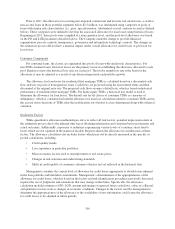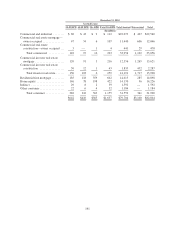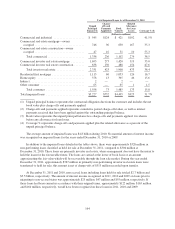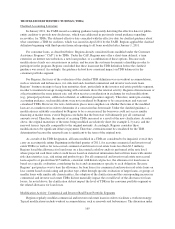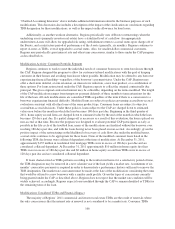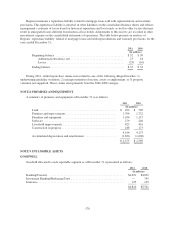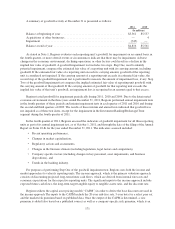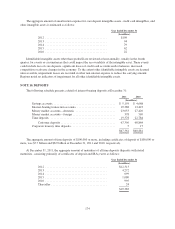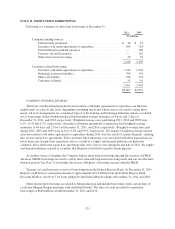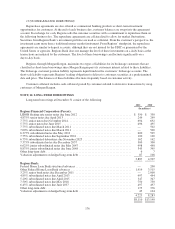Regions Bank 2011 Annual Report Download - page 190
Download and view the complete annual report
Please find page 190 of the 2011 Regions Bank annual report below. You can navigate through the pages in the report by either clicking on the pages listed below, or by using the keyword search tool below to find specific information within the annual report.
“Clarified Accounting Literature” above includes additional information related to the business purposes of such
modifications. This discussion also includes a description of the impact of the clarification on conclusions regarding
TDR designation for these modifications, as well as the impact on the allowance for loan losses.
Additionally, as another workout alternative, Regions periodically uses A/B note restructurings when the
underlying assets (primarily investor real estate) have a stabilized level of cash flow. An appropriately
underwritten A-note will allow for upgraded risk rating, with ultimate return to accrual status upon charge-off of
the B-note, and a satisfactory period of performance of the A-note (generally, six months). Regions continues to
report A-notes as TDRs, even if upgraded to accrual status. Also, for smaller-dollar commercial customers,
Regions may periodically grant interest rate and other term concessions, similar to those under the CAP program
as described below.
Modification Activity: Consumer Portfolio Segment
Regions continues to work to meet the individual needs of consumer borrowers to stem foreclosure through
the CAP. Regions designed the program to allow for customer-tailored modifications with the goal of keeping
customers in their homes and avoiding foreclosure where possible. Modification may be offered to any borrower
experiencing financial hardship—regardless of the borrower’s payment status. Under the CAP, Regions may
offer a short-term deferral, a term extension, an interest rate reduction, a new loan product, or a combination of
these options. For loans restructured under the CAP, Regions expects to collect the original contractually due
principal. The gross original contractual interest may be collectible, depending on the terms modified. The length
of the CAP modifications ranges from temporary payment deferrals of three months to term extensions for the
life of the loan. All such modifications are considered TDRs regardless of the term if there is a concession to a
borrower experiencing financial difficulty. Modified loans are subject to policies governing accrual/non-accrual
evaluation consistent with all other loans of the same product type. Consumer loans are subject to objective
accrual/non-accrual decisions. Under these policies, loans subject to the CAP are charged down to estimated
value on or before the month in which the loan becomes 180 days past due. Beginning in the third quarter of
2011, home equity second liens are charged down to estimated value by the end of the month in which the loan
becomes 120 days past due. If a partial charge-off is necessary as a result of this evaluation, the loan is placed on
non-accrual at that time. Because the program was designed to evaluate potential CAP participants as early as
possible in the life cycle of the troubled loan, many of the modifications are finalized without the borrower ever
reaching 180 days past due, and with the loans having never been placed on non-accrual. Accordingly, given the
positive impact of the restructuring on the likelihood of recovery of cash flows due under the modified terms,
accrual status continues to be appropriate for these loans. None of the modified consumer loans listed in the
following TDR disclosures were collateral-dependent at the time of modification. At December 31, 2011,
approximately $135 million in residential first mortgage TDRs were in excess of 180 days past due and are
considered collateral-dependent. At December 31, 2011 approximately $10 million in home equity first lien
TDRs were in excess of 180 days past due and $6 million in home equity second lien TDRs were in excess of
120 days past due and are considered collateral dependent.
If loans characterized as TDRs perform according to the restructured terms for a satisfactory period of time,
the TDR designation may be removed in a new calendar year if the loan yields a market rate. A minimum of six
months’ consecutive payments is required in order to demonstrate a performance history sufficient to remove the
TDR designation. The market rate assessment must be made at the date of the modification considering the terms
that would be offered to a new borrower with a similar credit profile. Given the types of concessions currently
being granted under the CAP as described above, Regions does not expect that the market rate condition will be
widely achieved; accordingly, Regions expects loans modified through the CAP to remain identified as TDRs for
the remaining term of the loan.
Modifications Considered TDRs and Financial Impact
The majority of Regions’ 2011 commercial and investor real estate TDRs are the result of renewals where
the only concession is that the interest rate at renewal is not considered to be a market rate. Consumer TDRs
166


